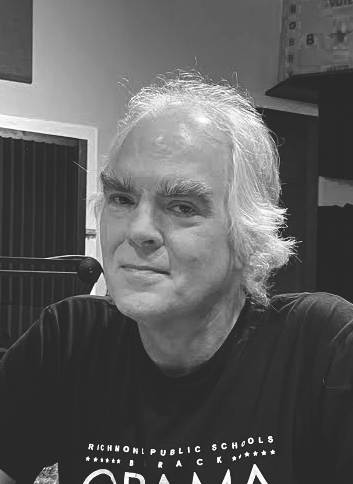The ancient sport of bowhunting.

Bob Foster
Photo by Adam Ewing
Cay McManus says that hunting with a bow and arrow is “a way of life” for her.
“It’s more personal than other kinds of hunting,” she says. “And challenging. You’ve got to get up close to the animal. And it’s not just about the kill.” For McManus, it’s about waiting, patience and enjoying the woods in the early morning, “before the world wakes up.”
McManus has been bow hunting for most of her adult life. She caught the fever years ago while working in a taxidermist’s office. “Come October, I was the only one working and everyone else was out,” she recalls. “I learned they all went bow hunting. I said, well, I’m going bow hunting too. I don’t want to be the only one working.” She laughs. “I had to get a bow, learn to shoot it, went through the proficiency course. I killed my first deer back in 1973, maybe.”
She doesn’t know how many she’s bagged since then. “I’ve been in Virginia for 35 years and almost every year, I got a deer.” These days, she tracks doe and buck (“I’ll shoot a turkey if I come across one”) behind her home in Altavista, 18 miles south of Lynchburg. Her hunting ground is 90 acres of forest shared with a neighbor.
“Everything’s pure instinct” when hunting with a bow, says Bob Foster, president of the Virginia Bowhunters Association and an instructor who teaches bowhunting and safety courses at the Ft. Belvoir Archery Range Complex in Fairfax County. “Like throwing a baseball and football, you look at the target and in your mind you feel the path of the arrow and what angle it should be at, and then release.” When he’s not hunting, Foster is a deputy chief information officer for the Department of Defense. “I bought my first bow in 1968. I was 16 years old at the time. There were no archery magazines that we enjoy today, no sportsman channels, there weren’t even any tree stands [harnesses that allow hunters to perch from a high angle] unless you built them yourself.”
Today, Foster says, “I hunt white tailed deer. I love white tailed deer. I have such a tremendous respect for them, they are magnificent animals. I don’t think there’s a harder animal to harvest, or a better trophy, anywhere in North America.” The biggest prizes are the bucks, which rarely come out in daylight. “So when you get the opportunity to take a mature white tailed buck, it is quite an accomplishment.”
The Virginia Bowhunters Association, established in 1941, celebrated its 75th anniversary in 2015. “In 2014, we had 1,725 members,” says Marie Bell, executive secretary of the VBA, who adds that there are more bowhunters in affiliated Northern Virginia clubs than any other region of the state. “We have one club called Nova Archers, with more than 500 members. Bow Hunters of Rockingam has more than 200. But a lot of the clubs are smaller clubs, with 30-70 members.” She says that when bowhunters kill an animal and can’t use the meat, it rarely goes to waste. Most donate to Hunters for the Hungry, an organization based in Big Island, which distributes the protein-rich food to needy families throughout the state.
Jon Robertson, who serves as hunting vice-president for the VBA, caught the bowhunting fever more than 25 years ago, when he took a bow that his late father had hanging on his wall and began to hunt with it. The Disputanta resident, who works at a chemical plant in Hopewell, says, “I don’t know if you’d call it a passion but it really exploded from there. You see something and just tinker with it, but now, for me, it’s an all-year thing.”
In addition to excursions in Colorado (where he describes “chasing elk”), Texas (for wild boar) and Canada (for bear), Robertson has hunted all over Virginia. But some spots pay off more than others: “As far as deer, Prince George County has been good to me. It’s close to home and nationally some of your hunters are taking notice of Prince George, Suffolk and Surry, the big deer that are growing there.”
A resident Virginia archery license costs $18, but hunters also need a general hunting license and a big game stamp to shoot specific animals, like deer or bear. And individual counties may have their own restrictions—Cay McManus says Bedford County has adopted an “earn a buck” rule in which hunters have to kill two does for every buck, for instance. The bowhunting season runs from the first weekend in October to the first weekend in November, unless the jurisdiction allows for early and late hunting, such as Fairfax and Chesterfield counties. And there is overlap. “During the gun season, you can use a bow, but you can’t use a gun in bow season,” explains Foster.

Sarah Paulus taking aim during practice.
Photo by Adam Ewing

Lee Baskerville in a tree stand.
Photo by Adam Ewing

Logan Weller (with binoculars) at the Ft. Belvoir Archery Range Complex.
Photo by Adam Ewing

Chance Beanum with his bow.
Photo by Adam Ewing
In July, the Virginia Department of Game and Fisheries publishes its annual hunting and fishing guidelines. Sportsmen, whether they shoot rifles, cast a line, set a trap or shoot an arrow are required to know the seasons, bag limits and all pertinent local and state regulations. Designated hunting time is 30 minutes before legal sunrise and the same time after legal sunset.
But not everyone is shooting with the same kind of bow. “There are four different types,” Foster explains. “There are the longbows. You remember Robin Hood and his merry men? Dating from the Middle Ages, they were very effective weapons for the time, lethal. These were superseded by crossbows, which also date to the Middle Ages. The crossbow is shot vertically, it has a horizontal bow across it, and it has a mechanical device that once it’s cocked, it holds it back and you fire it much like a modern firearm.” In 1953, the recurve bow was introduced, and it was a game changer. It was more efficient, stored more energy in the string and had great elasticity thanks to the use of a new material—fiberglass. Says Foster, “It was a technological advancement.”
Missouri engineer H. W. Allen Jr. patented the fourth style in 1969—the compound bow. Allen got the idea one day while hunting with a traditional weapon. “He shot at a deer and it stepped aside and just watched the arrow go by, again and again until Allen ran out of arrows,” says Foster. To increase the speed of the arrow, Allen’s compound bow utilized a system of levers and pulleys that create more tension while lessening the energy needed to pull the string. “Most hunters today shoot with a compound bow,” he adds.
David Burpee, a retired Army colonel from Fairfax, prefers an old-fashioned recurve bow when hunting. “It’s more of a challenge for the hunter to do well, and it’s more fair chase for the animal,” he says. “The animal has a better chance with me than if I was armed with a compound or shotgun or most certainly a rifle. The animal could be a couple hundred yards away and killed with a rifle, but I have to be close.”
How close? “Really good compound shooters can take a shot at 30-40 yards,” he explains. “But typically a longbow or recurve archer is not going to shoot over 20 yards. You can’t just go out and put your tree stand up and hope an animal wanders by. You have to look at the woods, trails, look for a sign of eating, where they drop their scat, something that would give you a hint that you can set up at 20 yards and maybe have a chance.” This requires, among other things, a keen awareness and control of one’s own scent. It’s “important for a compound hunter, it’s even more important for a traditional hunter,” explains Burpee. “The animal has a tremendous ability to smell you.” Burpee got into bowhunting more than 20 years ago. It’s a passion now. He primarily hunts deer in Northern Virginia, but he’s stalked caribou and bear in Canada, antelope in Wyoming and wild boar in Texas. “Every other year, I make a trip for moose in Canada,” he says.
Misconceptions about bow hunting abound, the archers say. “There’s been a lot of misinformation put out by anti-hunting groups, that bow hunting is inhumane and makes the animal suffer,” says Robertson. “But studies have shown that it isn’t true. I think it’s by far the most humane way to hunt.” McManus notes that when deer become overpopulated, it can lead to disease and the destruction of other animals’ habitats.
“I saw a deer recently and her ears were weighted down with so many ticks that they flopped over,” Foster says. “Those ticks carry Lyme disease. And then there are the deer eating residential gardens and vegetation. They say, ‘Look, they’ve prepared a banquet for me.’”
Fairfax County, where Foster hunts, has reached its cultural carrying capacity (the maximum number of individuals of a species that are tolerable to human populations) for deer, he says. “Therefore we have an extended season and have made it much more liberal to hunt deer, because we want to bring the deer population down, and this is an effective way to do it.”

Baskerville stalking through the woods.
Photo by Adam Ewing
Richmond artist Lee Baskerville got into bowhunting through his father, Henry. “My dad was a safari guide,” he says. They would go “off on hunting adventures around the world, places like Southern Africa, Argentina, Alaska, Mexico, Uruguay, Spain.” Though Baskerville doesn’t hunt for trophies anymore, he says, “I like to shoot one or two deer a year so I have meat in the freezer,” adding “I don’t really have the urge to get the biggest buck, for one thing they don’t taste very good, they tend to be very gamey when they get to be that big.”
For Baskerville, bowhunting gives a hunter the opportunity to raise the level of “challenge and fairness” in the sport. He says it requires hunters to understand their prey much more effectively than in other forms of hunting, and requires a major commitment “because you aren’t necessarily going to come back with an animal every time. There are some seasons when I haven’t gotten something, but that’s all part of it.”
Like many hunters, Baskerville says that much of the appeal of bowhunting is being surrounded by the wilderness all day. “I go to my hunting camp whether it is hunting season or not,” he says. “I don’t really get a special charge out of killing something, but if I’m going to do it, I’m going to do it respectfully.” VBArchers.com
This article originally appeared in our October 2015 issue.








